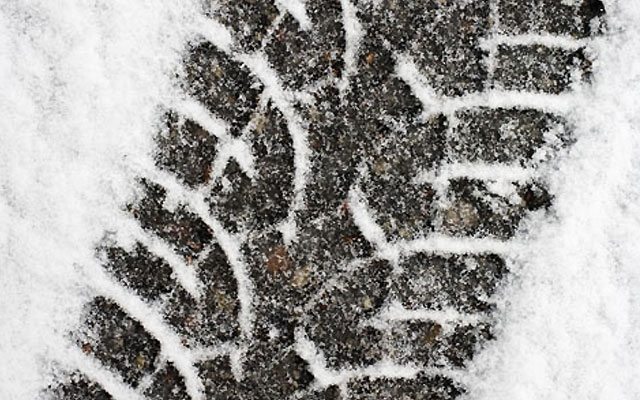Planning to drive in Europe in winter? Prepare for snow-covered and icy roads that are harder to drive on than ones back home.
In many countries, it's the law to fit winter tyres and carry snow chains. Even if it's not compulsory, it's a good idea to get winter tyres and practice fitting snow chains before you go.
Find out what the rules are in different countries across Europe.
Jump to country |
Local rules for winter tyres in Europe
The rules for winter tyres and snow chains can be different for residents and visitors. We've listed the rules for visitors in vehicles weighing up to 3,500kg.
Bear in mind that some 'M+S' (mud and snow) tyres sold in the UK are summer tyres. They won't meet the European requirements, even though the label might seem like they do. Make sure you check this at the garage before you buy.
Tyre tread in winter
If you're driving in winter, check your tyre condition, pressure and tread depth before you set off. The minimum tread for winter tyres is usually 3mm or 4mm, depending on the country you’re travelling to.
The minimum tread for regular tyres is 1.6mm but we'd still recommend 3mm for extra grip in winter.
Using snow chains
In many countries, it’s the law to carry snow chains in your car in winter months. These are metal chains that you can attach to your tyres to give you more grip on snowy roads.
Find out more about snow chains and how to fit them.
Get peace of mind in 44 countries with European Breakdown Cover.
Andorra
Winter tyres: Recommended
Snow chains: Carry chains and use as required by local signs or conditions. Reduced speed limits may apply.
Tyres must have at least 4mm of tread depth.
Austria
Winter tyres: Mandatory
Snow chains: Carry chains and use as required by local signs or conditions. Reduced speed limits may apply.
All vehicles on snow-covered roads must have winter tyres or all-season tyres marked M+S (mud and snow) between 1 November and 15 April. You must also use winter tyres if roads have a covering of snow, slush or ice outside these dates. Tyres must have at least 4mm of tread.
In theory, snow chains on summer tyres can be used where the whole road is covered with snow. But in practice, conditions can’t be predicted which makes winter tyres effectively compulsory.
Bulgaria
Winter tyres: Recommended
Snow chains: Carry chains and use as required by local signs or conditions. Reduced speed limits may apply.
Winter tyres are compulsory for vehicles registered in Bulgaria during wintry road conditions and are strongly recommended for visitors. Spiked tyres are forbidden. You must carry snow chains between 1 November and 31 March and use them when the relevant road sign is displayed.
Czech Republic
Winter tyres: Mandatory
Snow chains: Recommended
Winter tyres (marked M+S) with a minimum tread of 4mm must be used from 1 November to 1 April (period may be extended) on all wheels when there is compacted snow or ice on the road. They’re also compulsory whenever the temperature is lower than 7C and there is a possibility of snow or ice on the road.
Finland
Winter tyres: Mandatory
Snow chains: Permitted
Winter tyres are mandatory between 1 December and the end of February (but in practice from November to April) unless otherwise indicated by road signs. Tyres must be marked M+S on the sidewall with minimum tread depth of 3mm. You may use spiked or studded tyres from 1 November to the first Monday after Easter.
France
Winter tyres: Not mandatory
Snow chains: Carry chains and use as required by local signs or conditions. Reduced speed limits may apply.
Germany
Winter tyres: Mandatory
Snow chains: Carry chains and use as required by local signs or conditions. Reduced speed limits may apply.
All passenger cars and motorbikes including vehicles from foreign countries must be fitted with winter tyres or all season tyres on all axles when conditions are ‘wintry’. Winter tyres (or 'all season' tyres) should be marked M+S or have the snowflake symbol on the side wall.
Great Britain
Winter tyres: Not mandatory
Snow chains: Permitted
Read our guide to snow chains in the UK.
Italy
Winter tyres: Recommended
Snow chains: Carry chains and use as required by local signs or conditions. Reduced speed limits may apply.
Between 15 October and 15 April or at other times if conditions dictate. Provinces can introduce local legislation to make winter tyres and snow chains compulsory.
Norway
Winter tyres: Recommended
Snow chains: Carry chains and use as required by local signs or conditions. Reduced speed limits may apply.
You must use winter tyres or snow chains if snow or ice has covered the ground, but otherwise they’re not mandatory. Minimum tread depth is 3mm.
Slovakia
Winter tyres: Mandatory
Snow chains: Recommended
Winter tyres marked M+S with at least 3mm tread must be used from 15 November to 15 March and when there’s compacted snow or ice on the road.
Slovenia
Winter tyres: Mandatory.
Snow chains: Carry chains and use as required by local signs or conditions. Reduced speed limits may apply.
You use winter tyres marked M+S between 15 November and 15 March (and at other times under winter weather conditions). Tyres must have at least 3mm tread.
Sweden
Winter tyres: Mandatory
Snow chains: Recommended
Winter tyres, marked M+S (with or without spikes/studs), with a tread depth of at least 3mm must be used from 1 December until 31 March.
Switzerland
Winter tyres: Recommended
Snow chains: Carry chains and use as required by local signs or conditions. Reduced speed limits may apply.
Snow tyres aren’t compulsory but you could be fined if you hold up traffic and your vehicle’s not equipped for snow.
Published: 27 January 2021 | Updated: 27 January 2021 | Author: The AA

